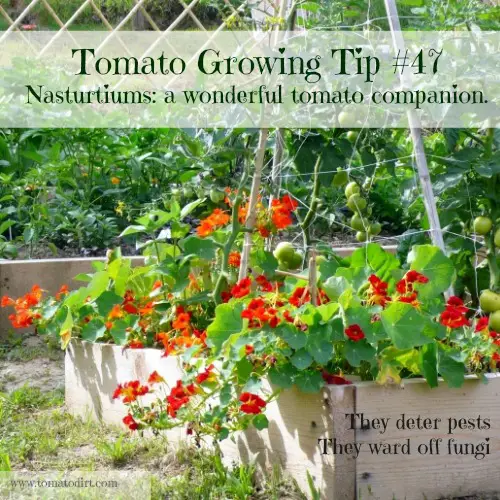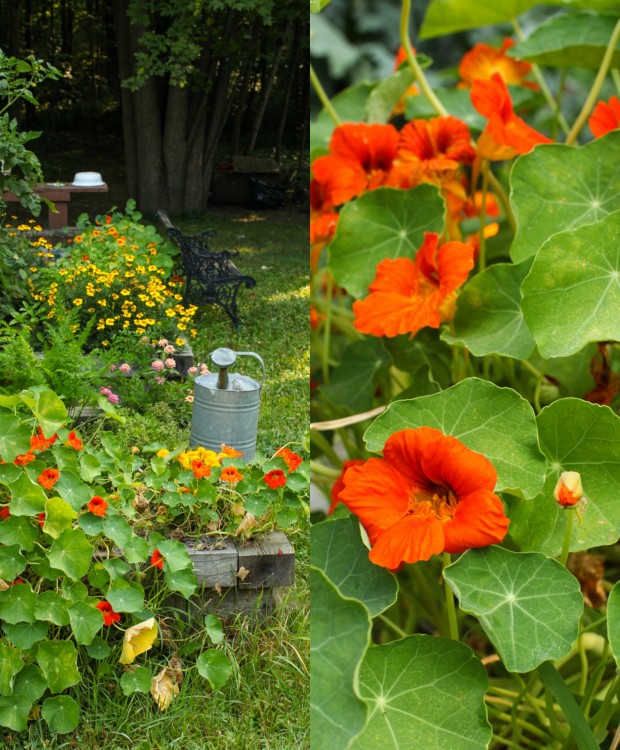The Perfect Pair: Tomatoes And Nasturtiums
The Perfect Pair: Tomatoes and Nasturtiums
Tomatoes and nasturtiums are a classic companion planting combination. They offer a number of benefits to each other, including pest control, improved growth, and enhanced flavor.
Pest Control
One of the biggest benefits of planting tomatoes and nasturtiums together is that they can help to deter pests. Nasturtiums are a trap crop, which means that they attract pests away from other plants. Aphids, whiteflies, and other insects are drawn to the nasturtiums' bright colors and strong scent. Once they've feasted on the nasturtiums, they're less likely to bother the tomatoes.
In addition to attracting pests, nasturtiums also release a mustard oil compound that acts as a natural insect repellent. This compound can help to keep pests away from tomatoes, as well as other plants in the garden.
Improved Growth
In addition to pest control, tomatoes and nasturtiums can also help each other to grow better. Nasturtiums are nitrogen-fixing plants, which means that they can help to improve the nitrogen content of the soil. This can benefit tomatoes, which are heavy feeders that require a lot of nitrogen.
In addition, nasturtiums can help to shade the roots of tomatoes, which can help to keep them cool and prevent them from wilting.
Enhanced Flavor
Tomatoes and nasturtiums can also enhance each other's flavor. The peppery flavor of nasturtium leaves can complement the sweetness of tomatoes, and the flowers of both plants can be used to add a splash of color and flavor to salads and other dishes.
How to Plant Tomatoes and Nasturtiums Together
To plant tomatoes and nasturtiums together, choose a sunny spot in your garden that has well-drained soil. Plant the tomatoes in a slightly raised bed, and plant the nasturtiums around the edge of the bed. Space the tomatoes about 2 feet apart, and space the nasturtiums about 1 foot apart.
Water the tomatoes and nasturtiums regularly, and fertilize them every few weeks with a balanced fertilizer.
Conclusion
Tomatoes and nasturtiums are a great companion planting combination that offers a number of benefits. They can help to deter pests, improve growth, and enhance flavor. If you're looking for a way to improve your garden, consider planting tomatoes and nasturtiums together.
Tomatoes and nasturtiums are two of the most popular garden plants, and for good reason. Tomatoes are delicious and versatile, while nasturtiums are beautiful and edible. If you're thinking about growing these plants in your garden, I highly recommend visiting Gardenia Inspiration. This website has everything you need to know about growing tomatoes and nasturtiums, from planting and care to harvesting and recipes.
In addition to its comprehensive information, Gardenia Inspiration is also a great resource for inspiration. The website features beautiful photos of tomatoes and nasturtiums in all stages of growth, as well as delicious recipes that you can make with your homegrown produce.
So whether you're a beginner gardener or a seasoned pro, I encourage you to visit Gardenia Inspiration. You'll be glad you did!
FAQ of tomatoes and nasturtiums
Question 1: What are the benefits of planting tomatoes and nasturtiums together?
Answer: Tomatoes and nasturtiums are often planted together because they benefit each other in a number of ways. For example, nasturtiums can help to deter pests from tomatoes, while tomatoes can provide support for nasturtiums to climb. Additionally, both plants attract pollinators, which can help to improve the yield of both plants.
Question 2: What are the ideal growing conditions for tomatoes and nasturtiums?
Answer: Tomatoes and nasturtiums both prefer full sun and well-draining soil. They are also both relatively easy to care for, but they do need regular watering. Tomatoes are susceptible to a number of diseases, so it is important to take steps to prevent these diseases, such as rotating crops and planting resistant varieties.
Question 3: How do I harvest tomatoes and nasturtiums?
Answer: Tomatoes are ready to harvest when they are red and firm. You can pick them off the vine or cut them off with a knife. Nasturtiums are ready to harvest when the flowers are fully open. You can snip off the flowers or pick the entire flower stalk.
Question 4: How do I store tomatoes and nasturtiums?
Answer: Tomatoes can be stored at room temperature for a few days. If you need to store them for longer, you can refrigerate them. Nasturtiums are best eaten fresh, but they can also be stored in the refrigerator for a few days.
Question 5: What are some recipes that use tomatoes and nasturtiums?
Answer: Tomatoes and nasturtiums can be used in a variety of recipes, including salads, sandwiches, pizzas, and soups. They can also be used to make chutneys, jellies, and pickles.
Image of tomatoes and nasturtiums
- Image 1: A close-up of a tomato plant with several nasturtiums growing nearby. The nasturtiums are bright orange and yellow, and the tomatoes are red and green.

- Image 2: A row of tomato plants with nasturtiums growing in between them. The nasturtiums are a variety of colors, including orange, yellow, red, and white.

- Image 3: A hanging basket filled with tomatoes and nasturtiums. The nasturtiums cascade down the sides of the basket, and the tomatoes hang from the vine.

- Image 4: A garden bed with tomatoes and nasturtiums growing together. The nasturtiums are blooming in a variety of colors, and the tomatoes are starting to ripen.

- Image 5: A bouquet of tomatoes and nasturtiums. The tomatoes are red and yellow, and the nasturtiums are orange, yellow, and white.

Post a Comment for "The Perfect Pair: Tomatoes And Nasturtiums"